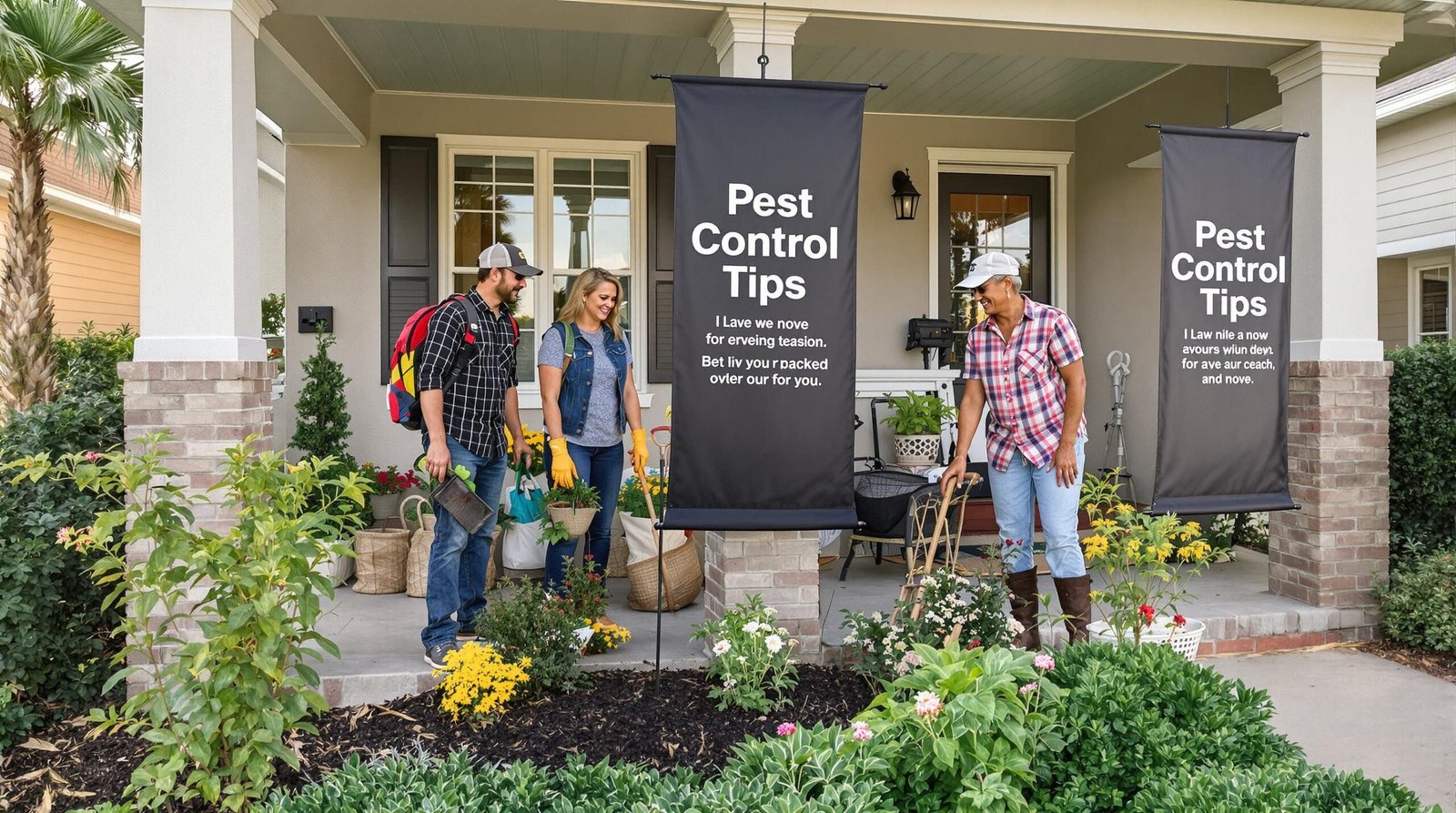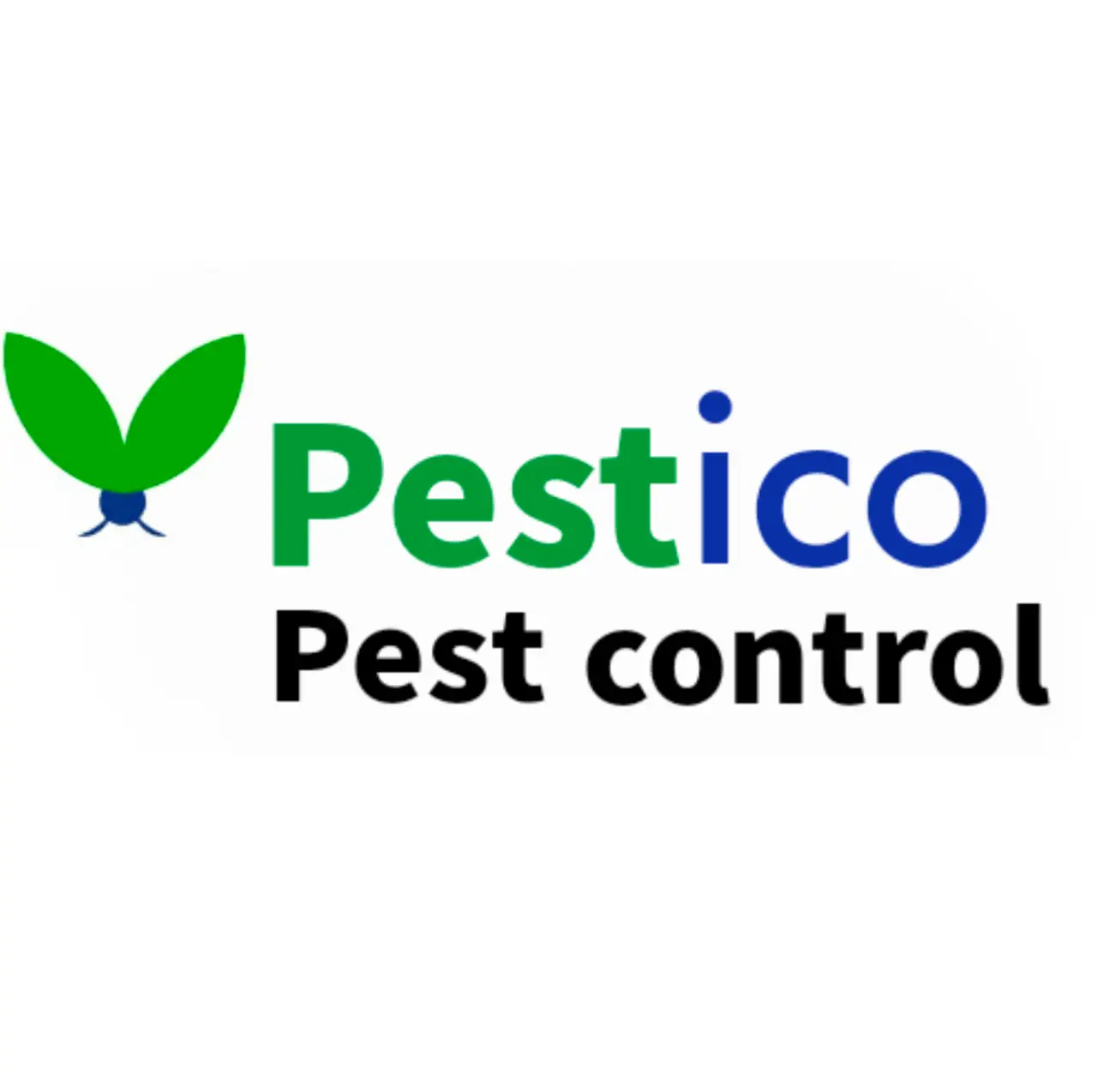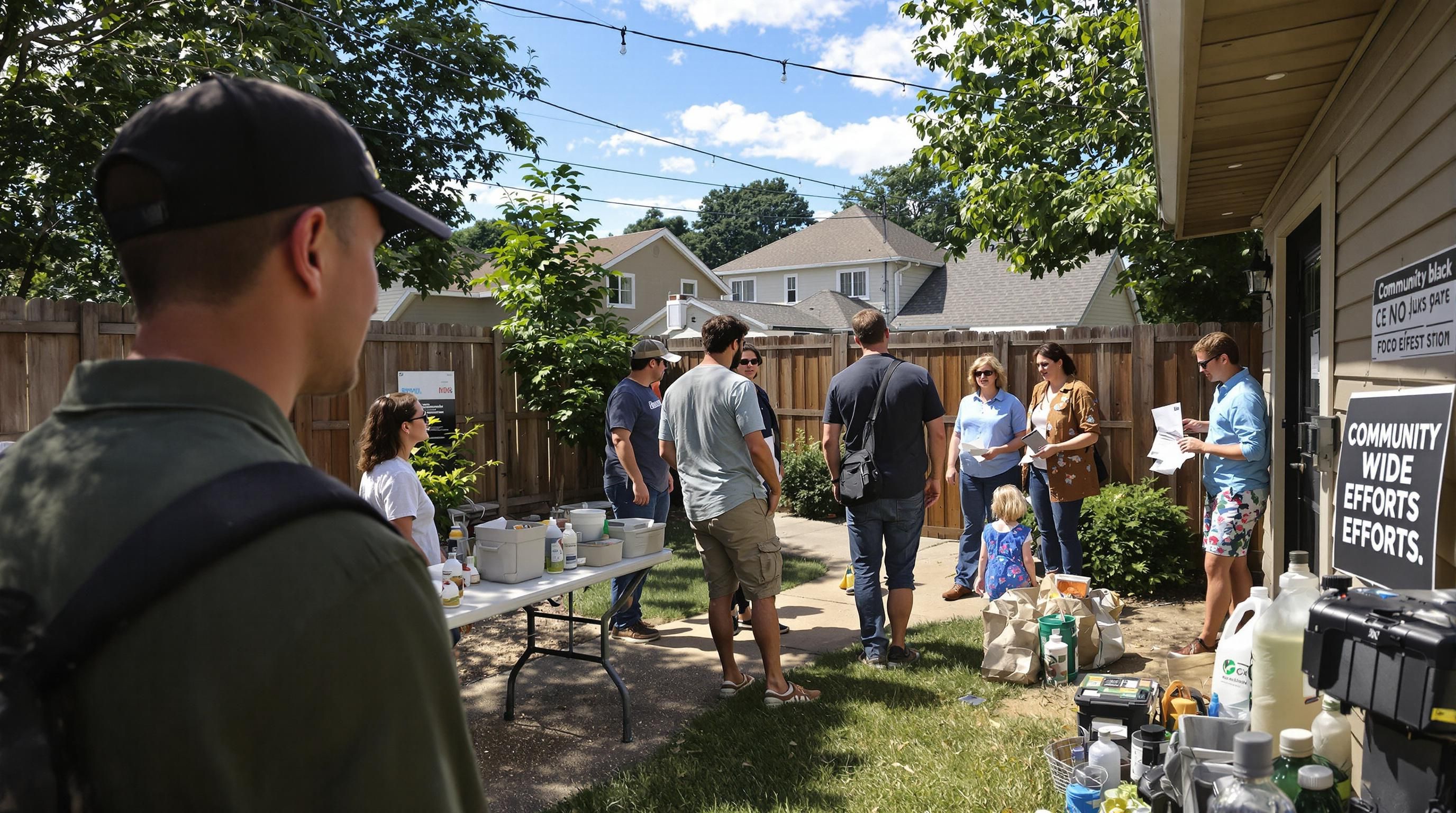
Neighborhood Pest Control Tips for Texas Homeowners 2025
Texas homes face an onslaught of pests every year, from relentless termites to biting mosquitoes and fire ants crowding out backyard barbecues. You might think a single spray bottle or monthly DIY effort is enough to keep these invaders at bay. But the truth is, experts say neighborhoods that coordinate pest control together can cut infestation rates by over 60 percent compared to going it alone. The power of community action changes everything.
Table of Contents
- Understanding Common Pests In North Texas
- Effective Prevention Strategies For Communities
- Safe Pest Control Solutions For Homes And Businesses
- Organizing Community-Wide Pest Management Efforts
Quick Summary
| Takeaway | Explanation |
|---|---|
| Identify common pests in Texas | Familiarize yourself with prevalent pests like termites, mosquitoes, and ants to take early action. |
| Seal entry points and eliminate moisture | Regularly check for cracks and leaks to prevent pests from entering your home. |
| Collaborate with neighbors for pest control | Form community groups to share information and resources for effective neighborhood pest management. |
| Adopt eco-friendly pest control methods | Use natural and low-impact treatments to safeguard your home, residents, and the environment. |
| Utilize technology for pest monitoring | Implement digital tools for reporting issues and tracking pest activities efficiently within your community. |
Understanding Common Pests in North Texas
Texas homeowners face a unique ecosystem of pest challenges that demand strategic and proactive management. The harsh climate and diverse landscape of North Texas create perfect breeding grounds for various insects and wildlife that can quickly turn from occasional visitors to full-blown infestations.
Identifying the Most Prevalent Household Invaders
North Texas harbors a remarkable variety of pest species that consistently threaten residential spaces. According to the National Pest Management Association, termites, mosquitoes, stinging insects, and ants represent the most common household pests in the region. Termites pose particularly significant risks, potentially causing extensive structural damage if left unchecked.
The Texas A&M AgriLife Extension Service reports that extreme heat and drought conditions are driving pests like cockroaches and scorpions indoors as they seek cooler temperatures and water sources. These environmental pressures create unique challenges for homeowners attempting to maintain pest-free environments. Cockroaches, for instance, can multiply rapidly and contaminate food preparation areas, while scorpions present potential health risks with their painful stings.
Understanding Seasonal Pest Behavior
Pest activity in North Texas follows distinct seasonal patterns that homeowners must understand to implement effective control strategies. During summer months, fire ants become particularly aggressive, creating extensive underground colonies that can damage landscapes and pose threats to humans and pets. Mosquitoes also reach peak activity during warm, humid periods, increasing risks of disease transmission.
Winter does not guarantee complete pest relief. Many insects seek warmth inside homes, creating indoor infestations that can be equally challenging. Rodents like mice and rats become more prevalent during colder months, seeking shelter and food sources within residential structures. These creatures can cause significant property damage and potential health risks through disease transmission.
Strategic Prevention and Management Approaches
Successful neighborhood pest control requires a comprehensive, multi-faceted approach. Homeowners should focus on sealing potential entry points, eliminating moisture sources, and maintaining consistent property maintenance. Regular inspections can help identify potential infestations before they become severe.
For those seeking more comprehensive guidance, our comprehensive pest prevention guide offers detailed strategies tailored to North Texas homeowners. Understanding local pest behaviors, implementing preventative measures, and working with professional pest control services can significantly reduce the risk of invasive pest problems.
By recognizing the unique challenges presented by North Texas’ diverse pest population and adopting proactive management techniques, homeowners can protect their properties and maintain healthy living environments.
To help you quickly identify the most common pests threatening North Texas homes and the risks they carry, see the table below.
| Pest | Season Most Active | Main Risks |
|---|---|---|
| Termites | Spring/Summer | Structural damage |
| Mosquitoes | Late Spring-Fall | Disease transmission (West Nile, etc.) |
| Fire Ants | Summer | Painful stings, landscaping damage |
| Cockroaches | Year-round | Food contamination, allergen source |
| Scorpions | Spring-Summer | Painful stings, potential allergic reaction |
| Rodents | Fall/Winter | Property damage, disease transmission |
| Stinging Insects | Spring-Fall | Stings, allergic reactions |
Effective Prevention Strategies for Communities
Successful pest management requires a collaborative approach that extends beyond individual household efforts. Communities in North Texas can significantly reduce pest populations by implementing coordinated prevention strategies that address environmental factors, communication, and shared responsibilities.
Collaborative Neighborhood Pest Management
Effective community pest control starts with collective awareness and proactive planning. According to the Texas A&M AgriLife Extension Service, urban integrated pest management programs emphasize community-wide education and sustainable prevention techniques. Neighborhoods can establish joint protocols that include regular property inspections, coordinated treatment schedules, and shared best practices for reducing pest habitats.
Neighborhood associations and local community groups can play a crucial role in organizing informational workshops, distributing educational materials, and creating communication channels for reporting potential pest issues. By developing a unified approach, residents can more effectively identify and address pest problems before they become widespread infestations.
Sustainable Landscaping and Environmental Management
The Texas A&M AgriLife Extension Service advocates for WaterSmart pest management techniques that focus on organic and environmentally friendly prevention methods. Communities can implement landscape design strategies that naturally discourage pest populations. This includes selecting native plant species resistant to local insects, creating proper drainage systems, and maintaining consistent landscape maintenance practices.
Shared green spaces and communal areas require special attention. Residents can collaborate to remove standing water, trim vegetation away from buildings, and create landscape designs that minimize potential pest breeding grounds. Mulching techniques, strategic plant placement, and reducing unnecessary moisture can significantly decrease attractive environments for insects and rodents.
Integrated Community Communication Systems
Establishing robust communication networks is critical for effective neighborhood pest control. Communities can develop digital platforms or local communication groups where residents can quickly share information about pest sightings, successful prevention methods, and potential community-wide treatment initiatives. Learn more about coordinating local pest prevention efforts.
Local government and homeowners associations can support these efforts by providing resources, organizing periodic community pest control events, and supporting professional pest management services that offer neighborhood-wide treatment options. Some communities have successfully implemented group discount programs for pest control services, making professional intervention more accessible and affordable for all residents.
By adopting a comprehensive, collaborative approach to pest management, North Texas communities can create more resilient, healthier living environments. Successful prevention requires ongoing commitment, communication, and a shared understanding of the unique challenges presented by local pest populations.
To clarify some of the key collaborative actions available, the following table summarizes popular community-wide pest prevention strategies mentioned above.
| Strategy | Description | Example Actions |
|---|---|---|
| Neighborhood Inspections | Joint property checks to spot early pest issues | Organize monthly walk-throughs |
| Educational Workshops | Community learning about pests and control | Invite local extension experts |
| Shared Treatment Schedules | Synchronize treatment timing for maximum effectiveness | Coordinate spraying across homes |
| Online Communication | Digital group chat or reporting platforms | Create a neighborhood app for pest alerts |
| Resource Sharing | Pool equipment and purchase supplies together | Share traps, split cost on repellents |
| Landscaping Improvements | Collective maintenance of green spaces | Remove standing water, trim communal vegetation |
Safe Pest Control Solutions for Homes and Businesses
Pest control in North Texas demands a strategic approach that balances effectiveness with safety for residents, pets, and the environment. Modern pest management solutions prioritize integrated techniques that minimize risks while providing comprehensive protection for homes and businesses.
Eco-Friendly and Low-Impact Treatment Methods
Environmental consciousness has transformed pest control strategies. Professional services now emphasize targeted treatments that reduce chemical exposure and environmental impact. According to the Environmental Protection Agency, integrated pest management focuses on identifying specific pest issues and applying the least toxic intervention possible.
Natural and organic pest control methods have gained significant traction. These approaches include using botanical insecticides, biological control agents, and physical barriers that interrupt pest lifecycles. For instance, diatomaceous earth provides a non-toxic alternative for controlling crawling insects, while essential oil-based repellents offer safe deterrent options for various pest species.
Advanced Safety Protocols for Residential and Commercial Spaces
Professional pest control services now implement rigorous safety protocols that protect inhabitants while effectively managing pest populations. Safest pest control methods prioritize minimal chemical use, targeted application techniques, and comprehensive pre and post-treatment assessments.
Businesses and homeowners should look for pest control providers that offer:
- Comprehensive inspection processes that identify specific pest challenges
- Targeted treatment plans minimizing chemical exposure
- Pet and child-safe application techniques
- Environmentally responsible pest management strategies
Technology-Driven Pest Prevention Approaches
Advanced technologies are revolutionizing pest control safety and effectiveness. Thermal imaging can detect pest populations within walls, while moisture monitoring systems help prevent conditions that attract insects and rodents. Smart trapping technologies provide real-time monitoring and early intervention capabilities.
Digital tracking and reporting systems allow for more precise pest management, reducing unnecessary chemical applications. These technological advancements enable pest control professionals to develop more targeted, less invasive treatment strategies that protect both human health and property integrity.
Implementing safe pest control solutions requires a holistic approach. Homeowners and business owners must collaborate with professional services that demonstrate commitment to safety, environmental responsibility, and comprehensive pest management. By prioritizing advanced, low-impact techniques, North Texas properties can effectively manage pest populations while maintaining a safe, healthy environment for residents and workers.
Organizing Community-Wide Pest Management Efforts
Successful pest management extends far beyond individual property boundaries, requiring collaborative approaches that unite neighborhoods in proactive prevention and control strategies. Communities in North Texas can significantly reduce pest populations by developing comprehensive, coordinated management efforts that leverage collective resources and expertise.
Establishing Integrated Pest Management Coalitions
According to the Texas A&M AgriLife Extension Service, forming robust Integrated Pest Management (IPM) coalitions represents a critical first step in community-wide pest control. These collaborative networks bring together homeowners, local government representatives, pest control professionals, and environmental experts to develop strategic, sustainable pest management approaches.
Key components of effective pest management coalitions include developing shared communication channels, establishing consistent reporting mechanisms, and creating standardized protocols for identifying and addressing pest challenges. Neighborhood associations can play a pivotal role by organizing informational sessions, facilitating communication, and coordinating community-wide prevention efforts.
Resource Sharing and Educational Initiatives
The Texas Cooperative Extension has demonstrated the power of collaborative educational programs through partnerships with organizations like Habitat for Humanity. By developing comprehensive home pest management education programs, communities can empower residents with knowledge and practical skills for effective pest prevention.
Effective resource sharing can include:
- Community workshops on pest identification and prevention
- Shared equipment for environmentally friendly pest control
- Group purchasing of pest control supplies
- Digital platforms for tracking and reporting pest activities
Learn how to effectively manage neighborhood pest control challenges through collaborative strategies that benefit entire communities.
Technology and Collaborative Monitoring Systems
Advanced technologies are transforming community-wide pest management efforts. Digital platforms and mobile applications enable real-time pest sighting reporting, allowing neighborhoods to track and respond to emerging pest challenges quickly. Geographic information systems (GIS) can help map pest populations, identify high-risk areas, and develop targeted intervention strategies.
Neighborhoods can implement smart monitoring systems that aggregate data from multiple properties, creating comprehensive pest activity maps. These technologies enable more precise, efficient, and environmentally responsible pest management approaches that reduce reliance on broad-spectrum chemical treatments.
Successful community-wide pest management requires ongoing commitment, open communication, and a shared understanding of local ecosystem dynamics. By fostering collaboration, investing in education, and leveraging technological innovations, North Texas communities can develop resilient, sustainable approaches to pest control that protect both property and public health.
Frequently Asked Questions
What are the most common pests in Texas?
The most common pests in Texas include termites, mosquitoes, fire ants, cockroaches, and scorpions. These pests can pose significant risks to homes and health if not managed properly.
How can I prevent pests from entering my home?
To prevent pests from entering your home, seal any cracks and openings, eliminate moisture sources, and maintain regular property inspections. Regular maintenance and early action can significantly reduce infestation risks.
Why is neighborhood collaboration important for pest control?
Neighborhood collaboration can reduce infestation rates by over 60% compared to individual efforts. By sharing resources and strategies, communities can effectively address and manage pest issues together.
What eco-friendly pest control methods are available?
Eco-friendly pest control methods include using botanical insecticides, biological control agents, and physical barriers. Organic treatments are effective in minimizing chemical exposure while still protecting your home and environment.
Take Neighborhood Pest Control Off Your Worry List
Is your Texas neighborhood struggling with termites, mosquitoes, and other relentless pests just like the ones described in the article? You already know that DIY solutions and isolated efforts are not enough. The real solution is a coordinated, community-wide approach supported by experts who understand the unique pressures of North Texas seasons and pest behaviors.
The good news is that you do not have to tackle this challenge alone. Our family-owned team at Pestico offers trusted pest, termite, mosquito, and rodent control services designed to help entire communities prevent costly damage and protect property values. Our affordable and high quality solutions deliver long-term relief for neighborhoods that want results. Ready to experience the difference? Start by exploring our safest pest control methods or talk directly to us through our website so your area can win the fight against pests together. Do not wait until small problems turn into infestations! Reach out to Pestico now and build a safer, healthier neighborhood.
Recommended
- 2025 Home Pest Prevention Checklist For Texas Residents – Pest Control Van Alstyne, TX – Pestico Pest Control
- Pest Control Scheduling Guide 2025 For Texas Homeowners & Businesses – Pest Control Van Alstyne, TX – Pestico Pest Control
- DIY Pest Prevention Tips – Pest Control Van Alstyne, TX – Pestico Pest Control
- Eco-Friendly Pest Control Methods For Texas Homes In 2025 – Pest Control Van Alstyne, TX – Pestico Pest Control


